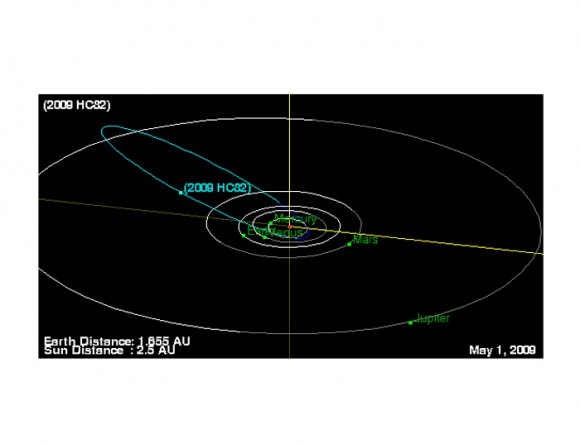The Solar System often throws up surprises for astronomers, but the recent discovery of a 2- to 3-km wide asteroid called 2009 HC82 has sent observers in a spin. A retrograde spin to be precise.
This particular near-Earth asteroid (NEO) should have already been spotted as it has such a strange orbit. It is highly inclined, making it orbit the Sun backwards (when compared with the rest of the Solar System’s planetary bodies) every 3.39 years. What’s more, it ventures uncomfortably close (3.5 million km) to the Earth, making this NEO a potentially deadly lump of rock…
2009 HC82 was discovered on April 29th by the highly successful Catalina Sky Survey, and after independent observations by five different groups, it was determined that the asteroid has an orbit of 3.39 years and that its orbit is very inclined. So inclined in fact that the asteroid’s orbit takes it well out of the Solar System ecliptic at an angle of 155°. Inclined orbits aren’t rare in themselves, but if you find an asteroid with an inclination of more than 90°, you are seeing a very rare type of object: a retrograde asteroid.
The last time I wrote about a retrograde asteroid was back in September 2008 (Kuiper Belt Object Travelling the Wrong-Way in a One-Way Solar System), when a University of British Columbia researcher spotted a rather unique retrograde Kuiper belt object (called 2008 KV42) that had a large looping orbit with an inclination larger than 90°. It was nicknamed “Drac” after Dracula’s ability to walk on walls.
2009 HC82 is therefore not only rare, it is also very strange. It orbits the Sun the wrong way (therefore making it very inclined), it is a potentially hazardous NEO (it is smaller than the 10 km asteroid that is attributed to wiping out the dinosaurs, but it would cause significant devastation on a global scale if it did hit us) and it is very eccentric.

All these orbital components have led to speculation that 2009 HC82 is in fact a “burnt out” comet. Comets originate from the Oort Cloud, a theoretical region cometary nuclei that occasionally gets nudged by gravitational disturbances when stars pass by. The Oort Cloud is not restricted to a belt along the ecliptic (like the asteroid belt or the Kuiper belt), it encapsulates our Solar System. Therefore, this may explain 2009 HC82’s bizarre trajectory; it was a comet, but all the ice has vaporized, leaving a rocky core to fling around the Sun on a death-defying orbit, buzzing the inner Solar System.
Brian Marsden of the Minor Planet Center agrees that some retrograde asteroids could be burnt-out comets. The size and shape of the new asteroid’s orbit “is very like Encke’s comet except for inclination,” he said, but the only difference is the fact that 2009 HC82 has no cometary tail.
More observations are needed before a definitive conclusion can be made, but Marsden is confused as to why this object has not been discovered before now. “It should have been easily observable in 2000,” says Marsden. “Why wasn’t it seen then?”
It is hoped further investigation may answer this question…
Source: New Scientist


whens it supposed to make another close approach?
This is one rock for me to disregard.
Perhaps imaging & spectroscopy by Hubble, Spitzer or a large ground-based telescope when this object is again near perihelion would help to answer the comet-asteroid question.
It has scooted on by the Earth 100s of thousands of times, most likely. I don’t think I will worry about it hitting us any time in the near future. I most certainly have a much greater chance of being hit by a car while jay walking than this comet/asteroid hitting Earth in my lifetime. However, it is possible. I will still sleep well tonigh.
Woah, thanks Feenixx… I got that information from my notes on the subject… obviously was not paying attention! Cheers, I’m changing that now, horrible error… next time all I need to do is look on Wikipedia..
Cheers!
Ian 😉
the article first says “a 2- to 3-km wide asteroid”… and later on, it states that it is “…of similar dimensions to the asteroid that is attributed to wiping out the dinosaurs” .
All articles I read about the subject estimate the asteroid which is considered the main factor in the extinction of the dinosaurs to have been about 10 km wide…. which makes it about 60 times more massive…. large enough to scare me, nevertheless… but, thanks be to Goodness, not quite close enough to cause me sleepless nights, for now.
The most scary bit about this discovery, to me, is the fact that it (the discovery) didn’t happen years ago.
Very nice find! I updated my orbits article on Comet, Asteroid and Meteor near misses and impacts at http://mangsbatpage.433rd.com/2009/05/orbits-cometasteroidmeteor-close.html
I found some interesting things about this object.
Presently it is a 20.3v magnitude object in the north constellation of Bootes, which makes it just past opposition. The position is 14h 22.7m +27 deg 07′ (May 7th)
The next closest approach to the Earth will be the 15th August, 2012, when it will lie 0.524 AU away (c. 78 million kilometers) in the constellation of Hydra. Magnitude will be c.18.5v
(At least is certainly off the doom-sayers list as targeting Earth for its presumed Mayan catastrophe!)
Hon. Salacious B. Crumb
Thank you very much on the est. mag about 15Aug2012,- at 18.5, this is well beyond the reach of all amateur backyard telescopes unless they had a time exposure of 24hours using a 30inch or .75meter scope!!!
NOOOO, the Mayas were right! FLY!!!
😀
So… is this an example of the type of object that would come at us out of the sun and only give us say, three weeks notice before it hit?
Owwie………….~*
@Aqua – not in this case more like from above or below and head on. Except this one doesn’t get that close. But size-wise yes.
Now 2003 SQ222 in Sep 2003 was an out of the sun surprise but thankfully a small one.
Why not look at this object as an opportunity? It comes within 3.5 million km of Earth. Its’ orbit stretches from inside Venus’ orbit to outside Jupiters’ orbit. Sounds like a great location for a robotic outpost to gather measurements from a range of solar radii and inclinations. Possibly some commercial interest from mining potential minerals from this object?
The object itself doesn’t seem to get any closer than about about 15M km. This seems to happen in clusters of 4 or 5 spread fairly evenly over about 60 years. The last group started about 1610, the next 2019.
@Jon – possibly but it’s retrograde so the delta-V will be huge.